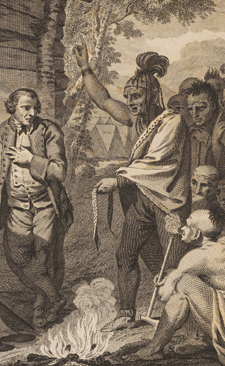
Vanished Worlds, Enduring People
Native Americans of the Northeast
The northeastern tribes of the United States and Canada are well represented in the Native American Collection. Early manuscripts include a 1765 Treaty with the Delaware, and Joseph Brant’s 1799 letter to John Johnson. Much of the history of the Stockbridge Indians, who settled temporarily in Stockbridge, Massachusetts after they were driven from territory along the Hudson River, can be traced in the library’s collection of their papers. Similarly, the library’s Passamaquoddy records illuminate the issues faced by Maine Indians in the Revolutionary War era and beyond. Early published materials shown throughout this exhibition shed light on the history of many native northeastern groups.
Other papers document native groups living in the northeast in the twentieth century. The artist and politician Joseph Keppler, whose papers are in the Native American Collection, wrote regularly to a number of friends on the Tonawanda and Cattaraugus reservations in the first half of the century. Their surviving letters to him relate details of reservation life. Keppler also corresponded with noted Seneca anthropologist Arthur C. Parker.
Native voices speak from the Native American Collection. The Pequot autobiographer William Apess, the native poet E. Pauline Johnson, and artist Jesse Cornplanter are represented in books and other documents. Newspapers such as Akwesasne Notes (1969-1996) and Cornell’s own magazine, Native Americas (1995 to present), inform the world of native issues, while writers such as novelist and poet Joseph Bruchac and poet Maurice Kenny claim space on the library’s shelves. Today’s eastern Native Americans, along with those from all over the hemisphere, will increasingly inform Cornell’s growing collection documenting America’s native peoples.